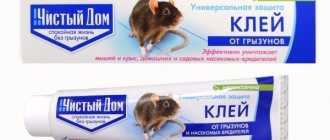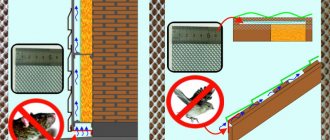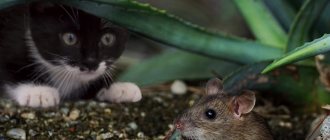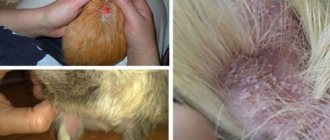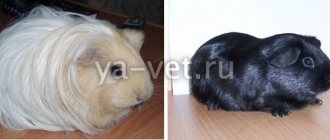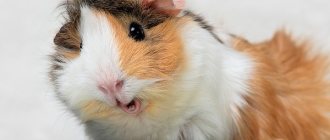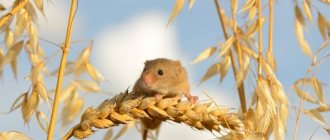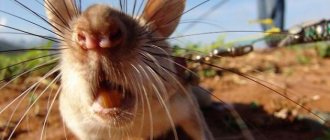Mice are rodents that do not suffer from lack of appetite and can cause enormous damage to food supplies. These animals are considered omnivores, but they have a keen sense of smell and will not try products that contain chemical additives.
And if you know what mice eat in the wild, many mistakes when forming the diet of a domestic decorative rodent can be avoided.
What do wild mice eat?
You can find mice in deciduous, tropical and coniferous thickets all over the planet. Omnivorous rodents adapt to rather difficult conditions and find suitable food for themselves in forests, meadows, swamps, steppes, taiga and the tropics. If possible, they settle as close as possible to human habitation, where it is easiest to get food.
Of the more than 400 varieties in Russia, three are most often found: house, field, forest.
Food of different types
House mice are quite omnivorous and voracious, with an active metabolism. The list of foods that these animals eat with pleasure includes:
- grains (millet, oats, wheat), seeds (sunflower, pumpkin), legumes;
- dairy products;
- bread;
- all types of meat;
- vegetables (cabbage, cucumber, carrots, beets) and greens (dandelions, green grass);
- fruits;
- insects and their larvae.
House mice find part of their diet in natural areas, but a significant percentage of their food is provided by people - rodents can easily steal food from the kitchen or cellar, or conduct active searches in discarded garbage.
Field mice prefer not to strain and not move long distances when obtaining food. What is planted on the field is enough for them:
- wheat;
- barley;
- corn;
- sunflower;
- oats;
- buckwheat;
- peas.
As fresh greenery, voles happily eat weeds in the inter-rows of cultivated plants and can gnaw on all kinds of tubers and bulbs. To store supplies for the winter, animals make burrows located close to the surface of the earth, under shelters - branches or straw.
The diet of wood mice includes everything that can be found in their habitat. The variety of food is great:
- hazelnuts;
- plant and tree seeds;
- berries;
- nuts;
- acorns;
- weeds and young greens;
- mushrooms;
- small insects and their larvae;
- eggs of small birds.
This type of rodent stores food in burrows, which it makes in tree hollows and under stumps.
Meals according to the time of year
In the wild, mice have to eat food that suits the time of year. The diet is distributed approximately equally for all species:
- plant foods in summer;
- juicy fruits, grains and seeds in autumn;
- stocks made in summer and autumn, as well as some root crops - throughout the winter and early spring.
Whenever possible, all types of mice approach people's houses, where there is always a chance of finding something edible (if not in houses or barns, then in fields and gardens).
Feeding rules
A mouse needs to eat enough food per day so that its weight is approximately one-fifth of the rodent’s live weight.
On average, an adult animal needs one teaspoon of grain mixture per day. There is a small “but”: food should always be in the cage. The fact is that mice eat every two to three hours due to their rapid metabolism. If the rule is ignored, the pet may develop health problems.
Be sure to put branches of fruit or wild trees and shrubs in the cage so that the rodents have the opportunity to grind down their teeth.
The food pyramid for mice looks something like this:
- proteins 14%;
- fats 10%;
- fiber 9%.
With any type of feeding, protein foods of animal origin must be offered once a week. This can be a boiled egg, boiled white chicken meat, freshwater crustaceans, fermented milk products, insects, etc.
Weakened animals, pregnant females, and babies can and should be given baby food. It will be especially useful if you are intolerant to natural milk.
Don't forget about vitamins and minerals. The first ones are given with food or dissolved in water.
Mineral supplements are sold in the form of figurines - mice love to chew on them.
You should never feed mice table scraps: any salty, sweet, smoked, fried, hot, spicy food is deadly for your pet. Even if human food does not destroy the tiny animal instantly, it will certainly lead to a faster death than is measured by nature.
Other harmful products:
- milk - many pets are intolerant;
- potatoes and their peelings;
- food for cats and dogs, although some owners note that mice love it;
- beet;
- tomatoes;
- cabbage;
- citruses;
- You should also not eat the green parts of potent medicinal herbs, especially those that are bitter: celandine, wormwood, gentian, etc.
Fresh water should always be in the cage.
It is better to use nipple drinkers, so the liquid will always remain clean. During transportation, you can use ordinary wet cotton wool as drinking bowls - the animals will suck water from it and will definitely not die of thirst during the journey.
What to feed a decorative mouse
The life of decorative mice at home is much simpler than that of their wild counterparts. An owner interested in a long and healthy life of an ornamental rodent must provide it with adequate and nutritious food in sufficient quantities. And a truly caring owner is also ready to personally compose food for his pet from the most useful ingredients.
Hard food
For ornamental mice, the basis of the diet is grain food, composed of a mixture of seeds of woody and/or herbaceous plants. You can select from the following components:
- Oats . Oat seeds contain more than 40% starch, about 14% protein and 4-5% fat, as well as B vitamins. Cereals that are in the stage of milky ripeness are especially useful for domestic rodents.
- Wheat . Rich in starch (at least 65%) and protein (up to 15%), not too fatty (only 2%), but contains mineral salts and vitamins PP, B-group. For normal metabolism, domestic mice should be given sprouted or soaked grains, not dry ones.
- Sunflower seeds for rodents are a very important component of the diet, healthy and highly nutritious (about 52% fat and up to 32% vegetable oil). It contains fatty acids and minerals in significant quantities, so the percentage of seeds in the feed mixture should not exceed 15%. With increasing dosage, pets may develop obesity.
- Millet . Red varieties of millet are considered the most useful and nutritious for ornamental mice. These seeds of cereal herbaceous plants are saturated with proteins, so their amount in the diet should be increased to 60-70%. Millet is given either in a mixture of dried seeds, or in its raw form - in panicles of milky-waxy ripeness.
- Legumes (soybeans, beans) are recommended to be given to mice in boiled form, peas - in the form of boiled cereal. These seeds are also quite nutritious; their abundant consumption leads to obesity.
In addition to cultivated plants, mice should be given seeds of wild plants, tubers, berries, roots, and nuts.
If the owner of decorative rodents does not want to prepare food mixtures on their own, you can buy specialized food in the store. The basis of such products are approximately the same components - oats, millet, wheat. They have a balanced composition of microelements, plant and animal proteins, fats and vitamins.
It is important to remember that you cannot feed mice exclusively with industrial mixtures; you must add natural ingredients - vegetables, fruits, berries, grass.
Juicy food
Juicy food - vegetables, root vegetables, melons, fruits and berries. For feeding rodents choose:
- Cabbage (except red cabbage). Savoy cabbage, white cabbage, cauliflower, broccoli are rich in vitamin C, amino acids and microelements necessary for the normal metabolism and life of mice.
- Rutabaga . Rutabaga contains a lot of glucose, 1-2% protein and fiber, 0.2% fat and a rich set of vitamins (C, P, B) with minerals (potassium, calcium, iron, phosphorus, magnesium and sulfur).
- Carrot . Carrots contain about 2.5% proteins and 12% sugars, making this root vegetable palatable. The product is useful for mice due to its saturation with vitamins and microelements; its regular use normalizes metabolic processes and has a positive effect on the condition of the sensory organs, skin and fur.
- Cucumbers . Low-calorie and not very nutritious cucumbers compensate for the mouse body's need for water, and also contribute to better absorption of nutritional components from grain feed.
- Apples . Can be given fresh or dried. The latter are best soaked for a couple of hours and boiled a little. Apples contain fructose, fiber and pectin, and are rich in beneficial microelements and vitamins. Pets are allowed to be given fruit without any signs of damage, let alone rotting.
- Pears . Pears can also be part of the diet of mice, however, due to the high sugar content, they must be given in limited quantities so as not to disrupt the animals’ metabolism.
- Strawberries (strawberries) . Strawberries and strawberries contain about 15% sugars (fructose and glucose) and 1% acids, pectin, vitamins (A, E, C, B-groups) and trace elements such as iron, phosphorus, cobalt, manganese.
Healthy! Green potato and juicy carrot tops, as well as the top leaves of cabbage, should be periodically added to the rodents' diet.
Among the succulent food that is beneficial for mice, we should also mention turnips, beets, potatoes and zucchini.
Ready-made feed
The simplest and least burdensome option for organizing the nutrition of any pets was and remains industrially produced food. There is one for mice too.
When choosing the right one, you always pay attention to both the manufacturer and the ingredients. Foreign products are still considered the best food for mice.
In any case, it is always necessary to carefully study the composition on the packaging and/or, if possible, try to visually determine the percentage of ingredients.
You should not purchase the following mixtures:
- with a high content of oats or grass granules,
- containing dyes,
- with a predominance of sunflower seeds, cumin or peanuts - these products should undoubtedly be included in the diet, but too much of them will lead to obesity,
- universal food for all types of rodents - nevertheless, the nutritional needs of all organisms, and even more so of representatives of different species, differ, and in some cases the difference is colossal.
What else can you supplement your diet with?
To prevent decorative mice from having problems with teeth grinding down, in addition to the main food, it is advisable for them to occasionally gnaw on pieces of spruce and pine needles, as well as tree branches:
- aspen;
- hazel;
- apple trees;
- and you;
- rowan.
The branches should be young and juicy, with high nutritional and taste properties.
It is advisable to supplement the diet of ornamental rodents with the following products:
- boiled meat (including well-processed spongy bones and cartilage);
- egg powder (or crushed boiled eggshells);
- milk and dairy products;
- cheese (in limited quantities);
- fresh lard;
- mineral additives (chalk, salt);
- fish oil;
- yeast;
- nuts (except peanuts).
What do rodents eat in captivity?
Living near humans, rodents eat any food. Most often these are fruits and vegetables, hard cheeses, milk, sugar, sausage, dried fish, bread. Among vegetables, the mouse willingly eats raw potatoes, carrots, and beets. House mice give birth to offspring up to 6 times a year. The litter contains about 10 mice, which by the age of 2 months are fully mature individuals. When rodents are hungry, they even feed on wood and paper, crushing them with their strong teeth.
If a mouse is kept in the house as a pet, it eats not only human food, but also the imported food offered to it. Such food does not contain husks or coarse grasses. They include nuts and seeds in a small percentage. Owners can provide their pets with a natural diet through seeds, cereals, protein products, vegetables and fruits, herbs, bread and cheese.
Is it possible to eat food spoiled by mice?
To answer the question of whether it is possible to eat, for example, carrots if mice have chewed them, it is worth remembering that mice are carriers of infectious diseases, many of which are dangerous to humans.
- Giardiasis affects the human small intestine, causing metabolic disorders.
- Rabies destroys the human central nervous system and can lead to death.
- Tularemia provokes ulcers at the site of infection, chills, fever, atypical pneumonia, and typhoid-like conditions.
- Hemorrhagic fever with renal syndrome is a viral disease accompanied by hemorrhages and kidney damage.
- Leptospirosis is a bacterial infection of the central nervous system, kidneys, circulatory and muscular systems.
- Toxoplasmosis is a parasitic disease that leads to neurological disorders, blindness, and paralysis.
Infection can occur through the feces, urine, and saliva of pests. So, when seeing food products nibbled by mice, it is necessary to keep in mind the threat of biological contamination and possible subsequent negative consequences.
How to choose bait for a trap?
To destroy rodents in your home, it is not enough to put a tasty morsel in a mousetrap. It is necessary to understand how mice move and where their habitats are. Rodents most often look for food at a distance of 10-25 m from the burrow. Mice are predominantly nocturnal animals; they can make up to 30 nightly forays for food. They move mainly along walls, under furniture. The mouse leaves a trail of excrement behind it. The droppings look like oblong grains, 0.3-1.2 cm in size, black in color.
Experts suggest using pieces of fatty protein food as bait: lard (smoked), bacon, butter, fried peanut or sunflower kernels.
A popular bait that has recently become popular is one made from a lump of peanut butter, which can be purchased at the supermarket. Unrefined sunflower oil on a piece of white bread has also long been an excellent bait for pests.
